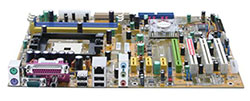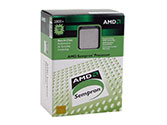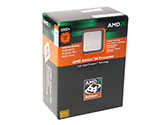Entry Level Buyer’s Guide, July 2005
by Jarred Walton on July 20, 2005 12:05 AM EST- Posted in
- Guides
AMD Recommendations
We have our base recommendation as well as an upgraded recommendation for the AMD side of the equation. The two systems are similar in many areas, but the choice of motherboard, CPU, and graphics card sets them apart.  |
 |
| Click images to enlarge. | |
Budget Socket 754 Motherboard: Foxconn nForce4 NF4K8AB-RS
Price: $78 shipped
Budget Socket 754 CPU: AMD Sempron 2800+ 1.6 GHz 256KB L2 (Retail)
Price: $83 shipped (Retail)
Total: $161
While our basic CPU recommendation remains the same as our last Budget Guide, you'll notice that we've switched motherboards. The main advantage of the Foxconn board is that we get a PCI Express slot, making it a more future-proof solution. Foxconn boards in the past have generally been conservative in approach, but early reports are that this particular board includes overclocking features that should allow you to reach at least a 250 MHz CPU bus if you're interested. (Our own tests with a similar Foxconn board for 939 maxed out at 235 MHz, though, so take those claims with a grain of salt.) The 8X multiplier of the 2800+ is the true limiting factor, giving you a range of 1.8 to 2.4 GHz for a 225 to 300 MHz bus - we figure that the Foxconn board will limit you to 2.0 GHz at best, though we have few doubts that the 90nm Sempron chips can easily run at that speed and more.
If you want better overclocking support, the EPoX EP-8NPAJ or ASUS K8N4-E Deluxe is probably a better choice. Our top pick for socket 754 overclocking continues to be the DFI LANPARTY UT nF3 250Gb, but you'd have to return to an AGP graphics card with the DFI board and we're hesitant to recommend that. The EPoX board only costs another $11, so it's a worthwhile upgrade for the enthusiasts, but the ASUS and DFI boards are quite a bit more expensive. If you're looking at spending that much money on a motherboard, you should probably upgrade to socket 939.
Those interested in cutting costs more can knock off another $11 by dropping to the Sempron 2600+. That has half the cache of the 2800+, but runs at the same clock speed. That should cut performance by about 5 to 7% for a 13% price reduction, but when you look at the total cost of the system, you're really only reducing the price by 2%. Going the other way and upgrading to a Sempron 3000+ or 3100+ is also an option, though the price of the 3100+ is near enough to the Athlon 64 3000+ we list below that we would recommend switching to that platform rather than purchasing a faster Sempron chip.
 |
 |
| Click images to enlarge. | |
Upgraded Socket 939 Motherboard: MSI nForce4 K8N Neo4-F
Price: $85 shipped
Upgraded Socket 939 CPU: AMD Athlon 64 3000+ 1.8 GHz 512KB L2 (Retail Venice core)
Price: $146 shipped (Retail)
Total: $231
For our upgraded AMD setup, we've selected the MSI K8N Neo4-F motherboard with an Athlon 64 3000+. We chose the retail version of the 3000+, though if you're willing to find a suitable HSF, you can get the OEM model for $119 right now. We prefer to avoid the hassle of finding a separate HSF and get the longer warranty, as the total difference in cost after shipping is only about $10. If you want a good overclocking setup, we can vouch for the capabilities of the Neo4-F and the CPU, and when paired with a quality HSF, it's not unusual to hit 2.6 GHz with the Venice cores. We've run some overclocked tests with this CPU and motherboard at 2.2 and 2.4 GHz over a two-week period and didn't experience any difficulties, but your mileage may vary with overclocking.
An alternative to either of these configurations that we've mentioned in the past is the MSI RS480M2-IL 939 board. That includes integrated graphics that are roughly equal to the Radeon X300SE HyperMemory in performance - in other words, the best of the IGP world, but still lacking in 3D performance. While the cost of the board is about the same as that of the Neo4-F, you no longer have to purchase a graphics card. That makes it a wash with the budget setup, but you get a faster CPU. Overclocking is not available on the RS480M2, however, so avoid it if you're interested in tweaking your system for higher performance levels.










57 Comments
View All Comments
bob661 - Wednesday, July 20, 2005 - link
#25Do you remember the cost difference?
Zebo - Wednesday, July 20, 2005 - link
"I once calculated the cost of running a 60W lightbulb 24/7 for a year and it was only about $37 - 526 kWHrs at 7 cents per kWHr. "=====================
Was this after your Dad told you to turn off the lights..he's not made of money? I did the same thing.:)
BTW I calculated X2 4200+ is cheaper than 820D dispite costing $250 more up front using the same formula (although I pay 14 cents per kWHr).
Zebo - Wednesday, July 20, 2005 - link
4/10 BTW which last time I checked was an "F".. as in Failure...as in Fu**ed up.Zebo - Wednesday, July 20, 2005 - link
LOL @ suggesting Dell. They have a 4 reseller rating for a reason ya know. They suck. Add in the fact you must get rebates, must get a "hot deal" to relise any savings you're much better off BYO normally.Zebo - Wednesday, July 20, 2005 - link
Nice to see those back and very good job Jarred.Of course I have issue with 1G of ram for a "value"setup.. Any video card with a one. And all should have LCD these days... simply not that much more, $50, for both more view area in 17" and much much better quality than any POS low end CRT.
KayKay - Wednesday, July 20, 2005 - link
Good Choice on the MSI Neo4-FAbecedaria - Wednesday, July 20, 2005 - link
For your Intel setup, I would think that a 2.4C (either on eBay or retail) would perform better than any of the options you mentioned for considerably less money. And you'd get 800FSB. And you'd get HT. Granted, the legacy socket 478 and AGP are going to limitations long term, but if you were going to go for better performance, you'd want to upgrade your video card and MB anyhow.abc
bob661 - Wednesday, July 20, 2005 - link
#18You were most likely CPU limited with that 6600GT in that system. A 9800 Pro wouldn't be.
bupkus - Wednesday, July 20, 2005 - link
I tried a 6600GT in my old system-- a Barton OC'd to 2.2GHz --and it didn't perform as well as my nephew's 9800 Pro on a Barton w/ a 333 fsb and mem, so I returned it.This Venice seems to perform pretty good without any tweaks. I'm using cheap of-the-shelf PNY 2x512 PC2700 DDR at all default settings. 2T, etc.
SDA - Wednesday, July 20, 2005 - link
>> I still feel like I keep repeating myself from Guide to Guide, but maybe you readers don't notice it as much? :)>>It's a good idea to repeat important points. You'll have no trouble remembering the recommendations you made in the last few guides, but what about readers that just look at the latest guide or forgot what earlier ones said once or twice on one page?
wrt the PSU, these systems will probably eat as much power as a couple incandescent lightbulbs, but that doesn't mean a Fortron or something isn't worth the money for an upgrade. At the very least, a better PSU is pretty much guaranteed to last longer (better elcaps, fans, etc.). Remember, there are some components in rock-bottom generics that will die even if you only draw about ten or twenty watts from the things for their entire lifetimes.
>>Anyway, I don't generally worry much about the mail-in rebate opportunities, as it's basically loaning a company your money at 0% interest for several months.>>
heh.. that's a great way of putting it. Shame that most people won't get it (how many times have you seen someone brag about a large tax refund?).